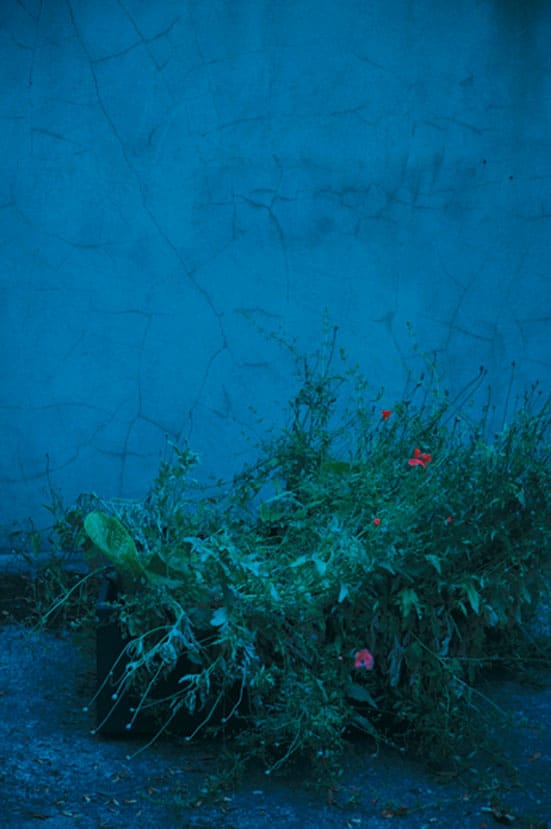3rd December 2006 — 21st January 2007
The
Seeds for a Random Garden project was originally conceived by
Boyle Family member Joan Hills in the late 1960s, and comprised
selections of seeds that she'd collected in a variety of determinedly
haphazard (if such a thing is possible) ways, along with suggestions
for random planting, with no consideration for the seeds' potential
usefulness or beauty. Forty years on, and following the death
of Boyle Family patriarch Mark Boyle, the Seeds for a Random
Garden project has been revived, and in something of a departure
of medium for the artists, takes the form of an eight-hour time-lapse
digital film, which is currently being exhibited for the first
time at Construction in Shoreditch.
For this work, a site in
south London was selected at random, from where dust and detritus
was swept up and planted in a box of clean earth. This was then
placed in an outside yard and a photo taken from a fixed position
every ten minutes, day and night, for exactly two hundred days
between May and November 2006. The resulting 28,800 frames, progressing
at a rate of one frame per second, add up to this lengthy eight-hour
piece. During the course of the film, a random selection of greenery
proceeds to sprout and grow, and then as autumn falls, to die.
Day turns to night and back to day. Two hundred times.
This description
might sound dull but actually there's a great deal to enjoy in
this piece. But before suggesting why, I'd like to pose a question
or two. Are we supposed to watch the whole film? When artists
decide on the length of such pieces - and installations with
such mammoth durations seem to be on the increase - is their
intention, if not their expectation, that spectators should experience
it in its entirety in order to engage fully with the work? Is
it fair to critique such work without having satisfied the somewhat
unrealistic premise that one should sit through the whole thing?
Or is that not really the point of this kind of durational art?
These are certainly questions worth pondering, but regardless,
I came in at about the six-hour mark, and watched for about an
hour. And it was an hour well spent. In fact, the tranquil confines
of the gallery, along with the meditative nature and silence
of the film itself, provided a welcome haven from the raucous
bustle of the East End.
The first thing that is particularly
impressive about the film is its striking use of rhythm - the
circadian cycle compressed into a couple of minutes but remaining
entirely commensurate with reality. When night falls and the
screen goes black for a while (save for the occasional tantalising
glimmer of moonlight), we find ourselves reflecting on the daytime
scenes we've just witnessed. Only in this darkness do we escape
from the relentless pulse of the daytime image changing every
second - a ticking clock made visual. Time marches on. As in
life, there is no pause button here.
It's surprising to see just
how much changes in the ten minutes between shots, in what might
initially appear a rather banal scene of a slightly unruly plant
amid nondescript surroundings. Leaves and stalks restlessly perk
and droop. Rain creates chaotic, ephemeral patterns as it splatters
and then soaks the wall before drying up as quickly as it appeared.
Fleeting mosaics of the shadows of leaves dance prettily across
the scene. Angular rays of brilliant sunlight make their bold,
methodical progress in and out of the frame. The shifts in the
quality and tone of the light, sometimes subtle, sometimes dramatic,
begin to reveal the whole spectrum of colour. The brief dusk
each evening, just a frame or two, becomes quite poignant.
By
making a subject of these humdrum 'weeds', the artists seem to
want us to question what plants we find 'beautiful' and why.
Why don't I know the names of these so-called weeds? Why don't
I care? Ultimately though, the work succeeds as a quietly powerful
meditation on the cyclic nature of ourselves and of the world
around us, and as a study in both chance and inevitability. An
eccentric experiment, that in typical Boyle Family style, seems
to have been blessed with a beguiling dose of serendipity.
DF
Construction
24a Calvin Street
London E1 6NW
http://www.constructionarts.co.uk/
Open
Wednesday-Sunday, 10am-6pm

Boyle Family
Still from time lapse film of 'Seeds for a Random Garden'
2006